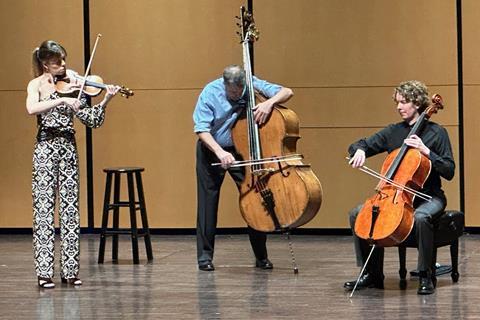Thomas May attends their concert of Bach and music by Meyer himself at the University of Washington’s Meany Center for the Arts in Seattle on 16 October 2024
 Tessa Lark, Edgar Meyer and Joshua Roman performing at Meany Center for the Arts, University of Washington in Seattle
Tessa Lark, Edgar Meyer and Joshua Roman performing at Meany Center for the Arts, University of Washington in Seattle
Officially launching their new nationwide US tour as a trio, violinist Tessa Lark, cellist Joshua Roman and bassist Edgar Meyer gave a concert replete with ear-opening delights at the University of Washington’s Meany Center for the Arts in Seattle. The programme combined one of J.S. Bach’s sonatas for viola da gamba with three string trios by Meyer – including his most recent composition, a trio written this year specifically for these colleagues.
Meyer and Lark have worked together on several projects over the last few years (including on Lark’s album The Stradgrass Sessions). Roman began collaborating with Lark after the pandemic left him with Long Covid – which he describes in this recent interview with The Strad – and invited her to join him on two of the selections on his new album Immunity. Moreover, a generation separates the 63-year-old Meyer from his trio partners.
Yet the threesome sounded as though they were a veteran band that’s been on the road for decades. Playing the entire programme from memory and maintaining faultless synchrony at rapid speeds, they seemed to be reading each other’s thoughts when trading off or taking phrases in a new direction.
Paradoxically, a sense of easeful spontaneity accompanied their unfaltering rhythmic connection. Particularly in Meyer’s own trios, with the bassist alternately bowing and plucking, they straddled elements found in classical, jazz and bluegrass style as effortlessly as if speaking one and the same language, never resorting to quotation marks.
First off was a thoroughly engaging account of Bach’s G major Sonata BWV 1027, the cello replacing the gamba and the violin and bass dividing the keyboard part between them (which itself had been arranged from a sonata for two flutes and continuo).
Bach is an important strand of inspiration in Meyer’s own music, which occupied the rest of the programme – as became clear in his long strands of melody with architecturally intriguing shapes, or the sense of infinite flow.
The Grammy-bestrewn Meyers reached back to two of the three string trios he wrote for himself, Daniel Phillips and Carter Brey to play at the Santa Fe Chamber Music Festival during the 1980s – as he wryly noted, ‘before Tessa was even born’. Simply titled after their respective years (’Trio 1986’ and ’Trio 1988’), each is cast in four movements.
Already in his 20s, Meyer was imagining new possibilities and contexts for his instrument, playing with registral extremes and stylistic gear-shifts absent of any fussy pretension. Duo passages for double bass and cello in the second movement of 1986, for example, evoked a rediscovered chorale, while a dactylic engine served as the ground for dizzying fiddle flights and syncopations in the finale.
The concert also introduced Meyer’s new Trio 2024, which has clear connections to the much earlier works but at the same time enters a world of its own. Meyer had started with a plan to record his trios from the 1980s with Lark and Roman and then decided to ‘complete the thought’ with the new one. At the end of the tour, they plan to record all four trios as a set.
Two denser outer movements frame a much shorter, interlude-like middle movement. Lark’s vibrato-less violin lofted ever higher in zigzagging gestures as cello and bass moved in contrary motion. This hyperactive environment left an impression of geometric constructions and vertiginous angles that made me eager to come back to it.
Meyer described the brief central movement, which seemed a slow-motion replay of the foregoing, as a ‘buffer’ between the busy outer ones. He added that the audience should ‘just think of this as a workshop’ – though the premiere proved highly satisfying as is.
An arrangement of Bach’s ‘Wachet auf’ chorale served as the encore, with Meyer, as throughout the concert, wrapped around his instrument and plucking notes of surprising delicacy. They never sounded like mere accompaniment but formed a subtle texture together with Roman’s steadfast chorale and Lark’s melody dancing atop.
Review: Bozzini Quartet
Review: Star power within the Seattle Symphony
Review: Festival round-up: Edinburgh International Festival 2024
Read: Latest reviews











































No comments yet